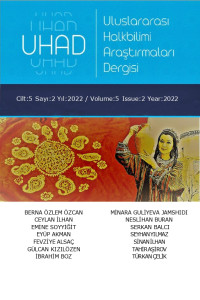Öz
Türklerin kadim sağaltma yöntemlerinden biri olan aydaş aşı pişirme geleneği, aydaş olarak nitelendirilen çocuklara yönelik Anadolu’nun bazı yörelerinde halen uygulanmakta ve halk üzerindeki etkisini önemli oranda korumaktadır. Bu geleneğin günümüzde varlığını sürdürdüğü yörelerden biri de Uşak ilidir. Tarih boyunca birçok medeniyete ev sahipliği yapmış en eski yerleşim yerlerinden biri olan ve halk hekimliğinin yaygın bir şekilde devam ettiği Uşak ilinde aydaş aşı pişirme geleneği ile ilgili henüz kapsamlı bir çalışmanın yapılmadığı tespit edilmiştir. Bu durum, bizi bahsi geçen konu üzerinde çalışmaya itmiştir. Çalışma kapsamında aydaş ve aydaşık kavramları, aydaşıklığın bir hastalık olarak ortaya çıkış nedeni ve aydaş aşı geleneğinin kökeni ile Uşak’taki mahiyeti üzerinde durulacak; aydaş aşının muhtemel şamanistik temeli, kültlerle bağlantısı, bir geçiş ritüeli olarak kabul edilip edilemeyeceği sorgulanacaktır. Çalışmanın amacı; Orta Asya Türk kültürünün bazı şamanistik unsurlarının günümüzde Anadolu'nun pek çok yöresinde görülen halk hekimliği pratiklerinden biri olan aydaş aşı geleneği ile bağının Uşak ili örnekleminde anlaşılmaya çalışılmasıdır.
Anahtar Kelimeler
Kaynakça
- ACIPAYAMLI, Orhan (1969). “Türkiye Folklorunda Halk Hekimliği ve Özellikleri”, Ankara Üniversitesi Dil ve Tarih-Coğrafya Fakültesi Dergisi, XXVI, s. 1-9.
- AÇA, Mustafa (2009). "Trabzon-Şalpazarı Çepnileri ile Çuvaş Türklerinin Doğum Sonrası Etrafındaki İnanış ve Uygulamaları Üzerine Bir Karşılaştırma Denemesi", Karadeniz Uluslararası Bilimsel Dergi, S. 1, s. 21-34.
- ARTUN, Erman (2015). Türk Halkbilimi. Adana: Karahan Kitabevi.
Öz
The tradition of cooking aydas food, which is one of the ancient healing methods of the Turks, is still applied to children who are described as aydas in some regions of Anatolia and maintains its influence on the public to a great extent. One of the regions where this tradition continues to exist today is the province of Usak. It has been determined that there has not been a comprehensive study yet on the tradition of cooking aydas food in the province of Usak, which is one of the oldest settlements that has hosted many civilizations throughout history and where folk medicine is widely practiced. This situation prompted us to work on the aforementioned subject.
Within the scope of the study, the concepts of aydas and aydasık, the reason for the emergence of aydasıklık as a disease, the origin of the tradition of the aydas food and its nature in Usak will be emphasized; The possible shamanistic basis of the symbiont, its connection with the cults, whether it can be accepted as a rite of passage will be questioned. The aim of the study is to try to understand the connection of some shamanistic elements of Central Asian Turkish culture with the tradition of aydas food, which is one of the folk healing practices seen in many parts of Anatolia today, in the sample of Usak province.
Anahtar Kelimeler
Kaynakça
- ACIPAYAMLI, Orhan (1969). “Türkiye Folklorunda Halk Hekimliği ve Özellikleri”, Ankara Üniversitesi Dil ve Tarih-Coğrafya Fakültesi Dergisi, XXVI, s. 1-9.
- AÇA, Mustafa (2009). "Trabzon-Şalpazarı Çepnileri ile Çuvaş Türklerinin Doğum Sonrası Etrafındaki İnanış ve Uygulamaları Üzerine Bir Karşılaştırma Denemesi", Karadeniz Uluslararası Bilimsel Dergi, S. 1, s. 21-34.
- ARTUN, Erman (2015). Türk Halkbilimi. Adana: Karahan Kitabevi.
Ayrıntılar
| Birincil Dil | Türkçe |
|---|---|
| Konular | Türk Halk Bilimi |
| Bölüm | Özgün Makale |
| Yazarlar | |
| Yayımlanma Tarihi | 29 Kasım 2022 |
| Gönderilme Tarihi | 19 Ekim 2022 |
| Yayımlandığı Sayı | Yıl 2022 Cilt: 5 Sayı: 2 |


